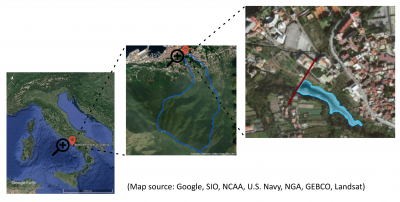Hydraulic risk mitigation in coastal basins with in-line expansion tanks: an integrated sizing approach
Flood detention basins are implemented to reduce peak flow rates, by temporary storing floodwater and releasing it downstream in a controlled way over a longer time. Existing methodologies for the design of these structures include simplified approaches based on a fixed designed inflow hydrograph and are also based on several assumptions. Such methods limit the possibility of a complete description of hydrological processes that occur during flood events, especially in small and ungauged basins. In this context, an integrated design procedure for the implementation of detention basins is proposed. Specifically, by applying probabilistic approaches and hydrological models, the current research project aims to define a methodology for the design of in-line detention basins according to the profit maximization rule, i.e. maximize profits reducing costs. On the one hand, flood events will be described in probabilistic terms to effectively define potentially inundated areas, on the other hand, mitigation effects, as well as expected damages, will be assessed according to the exposure of the assets. The proposed procedure can provide better insights into hydraulic and hydrological processes and advance knowledge about flood risk assessment and management.
Partners: University of Naples Federico II; University of Basilicata; Tuscia University
Research Group UNIBAS: Salvatore Manfreda, Cinzia Albertini, Domenico Miglino
Budget: 260.000,00 €

The case study
The investigated study area is the San Pietro Creek basin located in Castellammare di Stabia (Naples, Italy) (Figure 1). The San Pietro Creek is a torrential watercourse that originates from the northern part of the Lattari Mountains and flows into the Tyrrhenian Sea in the Gulf of Castellammare di Stabia. The river basin is a coastal watershed characterized by high slopes, a short concentration time and a high population density along the coastline, leading to frequent flooding and flash floods.

Deliverables:
Albertini, C., D. Miglino, V. Iacobellis, F. De Paola, S. Manfreda, Flood-prone areas delineation in coastal regions using the Geomorphic Flood Index, Journal of Flood Risk Management, (under review) 2021.
Manfreda, S., D. Miglino, and C. Albertini, Impact of detention dams on the probability distribution of floods, Hydrology and Earth System Sciences,25, 4231–4242, (doi: 10.5194/hess-25-4231-2021), 2021 [pdf]
Albertini C., D. Miglino, G. Bove, M. De Falco, F. De Paola, A. M. Dinuzzi, A. Petroselli, F. Pugliese, C. Samela, A. Santo, G. Speranza, S. Manfreda, Integration of a probabilistic and a geomorphic method for the optimization of flood detention basins design, Giornate di Idrologia 2021, Napoli, 29 settembre 2021 – 1 ottobre 2021.

